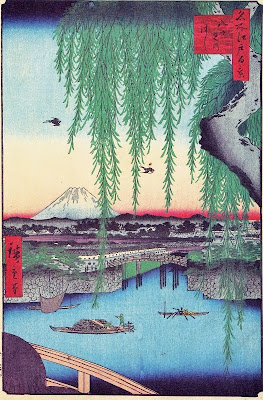今の上野公園、不忍池の景色です。
右手の小さな島の赤い建物は弁天堂。
この90景は2年前にも訪れ、ブログに書きました。その時は、どこで最後の一枚を撮ったらいいか、随分歩き回りました。というのもこの立派な「月の松」は明治の始めに台風でたおれて、もうないもので。(よかったらここで読んでみてください。)
This is Ueno and we are looking at Shinobazu Pond.
The red building on the small island on the right is Benten Shrine.
I wrote about this View 90 about two years ago here.
At that time, I had hard time deciding where to take the final photo, because this pine tree called Matsu of the Moon, or Moon Pine, was no longer there.
It was broken down by a typhoon about 150 years ago.
去年、親切な友人が新聞の切り抜きを送ってきてくれました。
それによるとこの「月の松」150年ぶりに復活するとのこと。
But last year, one of my friend sent me a clipping from a newspaper and taught me that they were planting a new Moon Pine!
それからずいぶんたってしまいましたが、やっと上野公園の清水堂に月の松を見に行くことができました。\(^o^)/
Finally, the other day, I made it to Kiyomizu-do in Ueno Park to see the tree. \(^o^)/
遠くからでもわかります。あれが月の松です!
Ooooh! That's the tree!
でも舞台に上がってよく見ると…
But when you look at it closely,
なんだか松がかわいそうなような……。
well..., they are giving the tree the hard time...?
切り抜きによると、清水堂の管理をする僧侶が4年ほど前に知人の造園業者に相談。直径1メートル半ほどの円形の鉄パイプで枝を固定して円形になるように育ててきたとか。とっても難しいことなんだそうです。
According to the paper, a priest at the Kiyomizu-do had this idea of replanting the Moon Pine and asked his friend/gardener more than four years ago. They set a round iron pipe, 1.5 meter in diameter, on a tree and guided the branch to form a circle. It wasn't easy, they say.
というわけで、前回の写真よりいいかどうか自信はありませんが、今回の一枚はこれです。
Though I'm not sure if this is any better than the old photo, this is the photo of the day.
立派な月の松になるのは100年後かな?がんばれ!
Maybe it'll be a majestic Moon Pine in , say, 100 years?

.jpg)
.jpg)
.jpg)
.jpg)
.jpg)
.jpg)
.jpg)
.jpg)
.jpg)
.jpg)
.jpg)
.jpg)
.jpg)
.jpg)
.jpg)
.jpg)
.jpg)
.jpg)
.jpg)
.jpg)
.jpg)
.jpg)
.jpg)
.jpg)
.jpg)
.jpg)
.jpg)
.jpg)
.jpg)
.jpg)
.jpg)
.jpg)
.jpg)
.jpg)
.jpg)
.jpg)
.jpg)
.jpg)
.jpg)
.jpg)